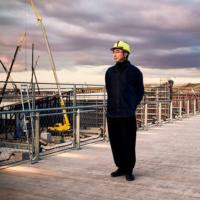To the south of the Yangtse River in China's Anhui Province, near the medieval city of Wuhu, rise the Huangshan mountains: a series of jagged peaks and crags, not very high, as mountains go, but intensely dramatic. The clouds and mist that swirl around their pine-crested heights, the mysterious grottoes and strangely shaped rocks, the waterfalls and hot springs that lurk in the deep-shadowed hollows have lured mystics, sightseers and painters since the Middle Ages. When one thinks of Chinese landscape painting it is the scenery of Huangshan that generally comes to mind.
During the 1960s a troubled teenager from Wuhu named Wang Wusheng climbed the highest peak of Huangshan, and there, where the earth reached the sky, he heard the mountains calling him.
The country was about to fall into the self-destructive frenzy of the Cultural Revolution, and Wang, a self-described "stubborn man," was one of its first targets at Anhui University. Nonetheless he weathered the storm, and in the early '70s, as a photographer for an Anhui newspaper, he began a series of working trips into Huangshan. The series stretched out over more than 20 years, and his show, "Celestial Mountains," at the Tokyo Metropolitan Museum of Photography in Ebisu until July 16, presents some of the results.

















With your current subscription plan you can comment on stories. However, before writing your first comment, please create a display name in the Profile section of your subscriber account page.